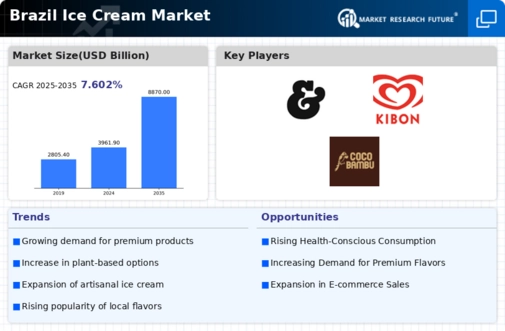The ice cream market in Brazil is characterized by a dynamic competitive landscape, driven by evolving consumer preferences and a growing demand for premium and innovative products. Major players such as Unilever (GB), Nestlé (CH), and General Mills (US) are actively shaping the market through strategic initiatives focused on product diversification, sustainability, and digital engagement. Unilever (GB) has positioned itself as a leader in the premium segment, emphasizing health-conscious options and plant-based alternatives, while Nestlé (CH) continues to leverage its extensive distribution network to enhance market penetration. General Mills (US) is also making strides by expanding its portfolio to include organic and natural ingredients, reflecting a broader trend towards healthier consumption.
The business tactics employed by these companies include localizing manufacturing to reduce costs and optimize supply chains, which is particularly crucial in a market as vast and diverse as Brazil. The competitive structure appears moderately fragmented, with a mix of multinational corporations and local brands vying for market share. This fragmentation allows for a variety of consumer choices, while the collective influence of key players drives innovation and sets industry standards.
In October 2025, Unilever (GB) announced a partnership with a local Brazilian startup to develop a new line of dairy-free ice creams, tapping into the growing trend of plant-based diets. This strategic move not only enhances Unilever's product offerings but also aligns with the increasing consumer demand for sustainable and health-oriented options. The collaboration is expected to bolster Unilever's market presence and appeal to a broader demographic.
In September 2025, Nestlé (CH) launched a new marketing campaign aimed at promoting its ice cream products through digital platforms, utilizing AI-driven analytics to tailor advertisements to specific consumer segments. This initiative underscores Nestlé's commitment to digital transformation and its recognition of the importance of engaging with tech-savvy consumers. By leveraging data analytics, Nestlé aims to enhance customer experience and drive sales growth in a competitive environment.
In August 2025, General Mills (US) expanded its distribution channels by entering into a strategic alliance with a prominent Brazilian supermarket chain. This partnership is designed to increase the availability of its ice cream products across the country, particularly in underserved regions. The move is indicative of General Mills' strategy to enhance its market footprint and ensure that its products are accessible to a wider audience, thereby driving sales and brand loyalty.
As of November 2025, current trends in the ice cream market are increasingly defined by digitalization, sustainability, and the integration of AI technologies. Strategic alliances are becoming more prevalent, allowing companies to pool resources and expertise to innovate more effectively. The competitive differentiation is likely to evolve from traditional price-based competition towards a focus on innovation, technology, and supply chain reliability. Companies that can successfully navigate these trends will likely secure a competitive edge in the ever-evolving landscape.














Leave a Comment